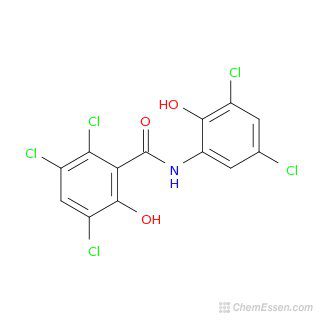
04 May Why is Oxyclozanide Important in Medicine?
Oxyclozanide is an anthelmintic drug used for the treatment and control of fascioliasis in cattle, sheep, and goats. The mechanism of action of oxyclozanide is the uncoupling of oxidative phosphorylation in flukes. It is formulated as an oral drench containing oxyclozanide only or in combination with levamisole hydrochloride or oxfendazole or as a powder to be incorporated in the feed. The recommended doses are 10 to 15 mg oxyclozanide/kg BW for cattle and 15 mg oxyclozanide/kg BW for sheep and goats. The application was amended to exclude sheep milk and goat tissues and milk.
Oxyclozanide is effective against the early and late stages of Fasciola hepatica infection in sheep and cattle. In sheep, a single oral dose of 10-15 mg/kg is effective against both early and late stages of infection. In cattle, two oral doses of 10 mg/kg, given two weeks apart, are required for effective treatment of early and late stages of infection. Oxyclozanide is also effective against other gastrointestinal nematodes, including Ostertagia ostertagi, in sheep and cattle. The drug is rapidly absorbed and metabolized in the liver, and excreted in the bile.
The most common side effect of oxyclozanide is diarrhea, which is usually mild and self-limiting. More serious side effects are rare, but may include anaphylaxis, hepatic necrosis, and photosensitivity. Oxyclozanide should not be used in animals with known hypersensitivity to the drug.
Oxyclozanide is a safe and effective anthelmintic drug for the treatment and control of fascioliasis in cattle, sheep, and goats. The most common side effect is mild diarrhea, which is usually self-limiting. More serious side effects are rare, but may include anaphylaxis, hepatic necrosis, and photosensitivity. Oxyclozanide should not be used in animals with known hypersensitivity to the drug.
Fascioliasis is an economically important disease caused by trematodes of the genus “Fasciola” that infect a variety of species, including humans, ruminants, and companion and zoo animals. Sheep are especially susceptible to infection with “F. hepatica”, and infections have been reported in dogs, cats, foxes, mink and other carnivores. Under field conditions, “F. hepatica” is considered a minor parasite in cattle; however, it can reach high levels in intensively managed animals where control programs may not be well established. The disease is controlled by anthelmintic drugs, by preventing access to the intermediate host (water snails) through the use of farm management practices or by grazing confinement or feeding hay only. Newer control methods using biological control agents are being developed.
http://eaavmadrid2011.es/chemical-structure-of-salicylanilides-and-its-uses-in-everyday-life/










